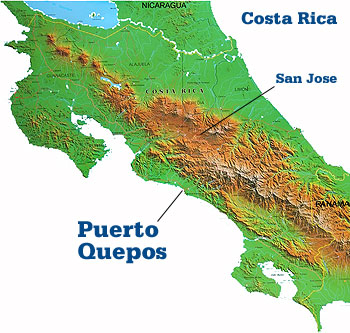We asked someone from the hike to go get the naturalist guide and verify that it was the fer de lance. When he eventually arrived and confirmed the species, he used his walking stick to persuade it off the walkway and down into the underbrush. The snake was not interesting in fleeing however, and actually tried to get back on the walkway.
Danielle had a hard time focusing on her dinner after the encounter, but I was personally thrilled to get some pictures and finally see the snake we heard so much about. That evening, our last night at Lapa Rios, we made a decision to visit an Animal sanctuary in the morning before our flight back to Pavas airport. We spent the rest of the evening getting to know the Canadian family and went to bed just before midnight. The next morning our Tico breakfast was waiting and we said goodbye to Lapa Rios.
We arrived at the doc in Puerto Jimenez and a nice 40 minute boat ride brought us to the shore of the mainland, across Gulfo Dulce, to an animal sanctuary just on the border of the Piedras Blancas National Park ( the dark green spot on the map ). The animal sanctuary was amazing.
Soon after the boat pulled up to the shore, the owner, a volunteer and a very special temporary residant named Sweetie (a 6 year old spider monkey) waited to greet us. Sweetie went immediately to Danielle, grabbed her hand, and pulled her down to show her where a spider (brown recluse family) had bitten her two years prior. It was amazing and I was speechless. She was doing exactly what she was naturally supposed to do -- socialize and be groomed by others. Were we taught that she was about equivalent in maturity of a teenage girl. Soon the hormones would kick in and she would venture off into the wild to search for a mate...but currently, she loved the attention, and her adopted family of the sanctuary.
Pulling up to the sanctuary
It was amazing being that close to a wild animal. Aside from the rules not to hold her, she loved the attention and spent time checking out everyone in our small tour group. Continuing on in the sanctuary, we saw a pair of coatis, macaws (they'd been kept in cages with no perch, so their wings had become deformed...they can no longer fly except in a straight line), a wolverine and wild pig -- both of which thought they were guard dogs because of how inhumanly were raised. Moving on, we got to see two sloths, a kinkajou, and finally an enormous enclosure containing a troop of white faced monkeys. This was probably the most touching part of the tour for me because these animals (think organ grinder monkey) all came from abusive beginning where their hope of returning to the wild is almost nil. I'll never get the image of the poor female that would clutch her hands together under her chin, shake her head rapidly, and rock back and forth nervously. Apparently she was forced in darkness and solitude in someone's basement for the majority of her life. Not like I needed additional evidence that humans and monkeys share recent lineage, but would be easy to see how a human would develop similar behavior and psychological disorders if forced in similar conditions. It's heartbreaking to see first hand what harm people can do to animals that should just be left alone. I forgot his name, the American that bought those 800 acres 14 years ago and left behind a successful career to peruse a dream, but I hope he's able to keep going. The locals mostly just don't have the appreciate of their environment yet. He has had some luck hiring ex-poachers however, but it's hard when the culture of this area is to hunt. A number of animals have nearly been driven to extinction due to poaching or exporting. For instance, only 1 out of every 75 scarlet macaws makes it alive through the export process. Or the Ocelot for instance -- a small cat of the region -- can be sold for exporters for $10,000.
A pair of two-toed sloths that were found on the ground near the sanctuary. Apparently if they fall, the mother doesn't have the energy to go back down and rescue them. It's true, they move very slowly... these two were found near the sanctuary.
Soon we were back on the boat and sitting on a bumpy flight to Pavas, followed by a short flight to Quepos.
We arranged transportation to Manual Antonio Estates and were a little disappointed with the "Wood Chalet" -- maybe 25 years ago it was something special, but with the heat, damp air, and complete shade, the whole place had a mildew smell. It was a little bit of a shock because we essentially had just come from paradise. We opened up all the windows and set the fans to high and tried not to let the accommodations get us too down. It was late afternoon, so we decided to walk down to the town of Quepos...we found this town pretty depressing. Personally it reminded me of any town poor town in mexico I've ever seen, except without all the tourist trinket shops. Our main reason staying here was to be near Manual Antonio National Park, so we tried to keep that in mind. People seemed nice however, despite the barbed wire fences and bars on all the windows just like we saw in San Jose. Unless you had the money to live in a gated community, you better invest on heavy duty bars and razor wire.
We picked up some Costa Rican beer (Imperial) and a few items at a little store. Danielle made us a delicious beans and rice dinner back in our gated community, then it was off to bed.









No comments:
Post a Comment